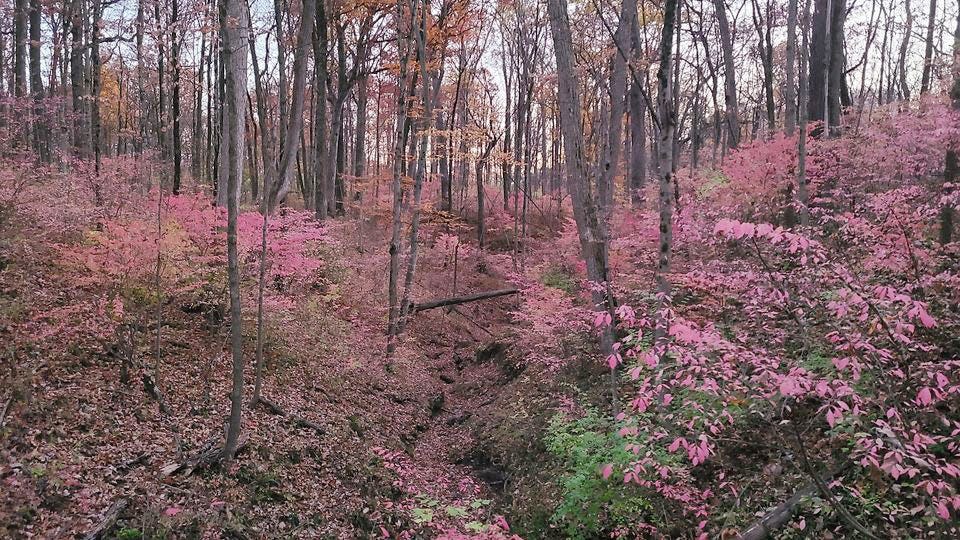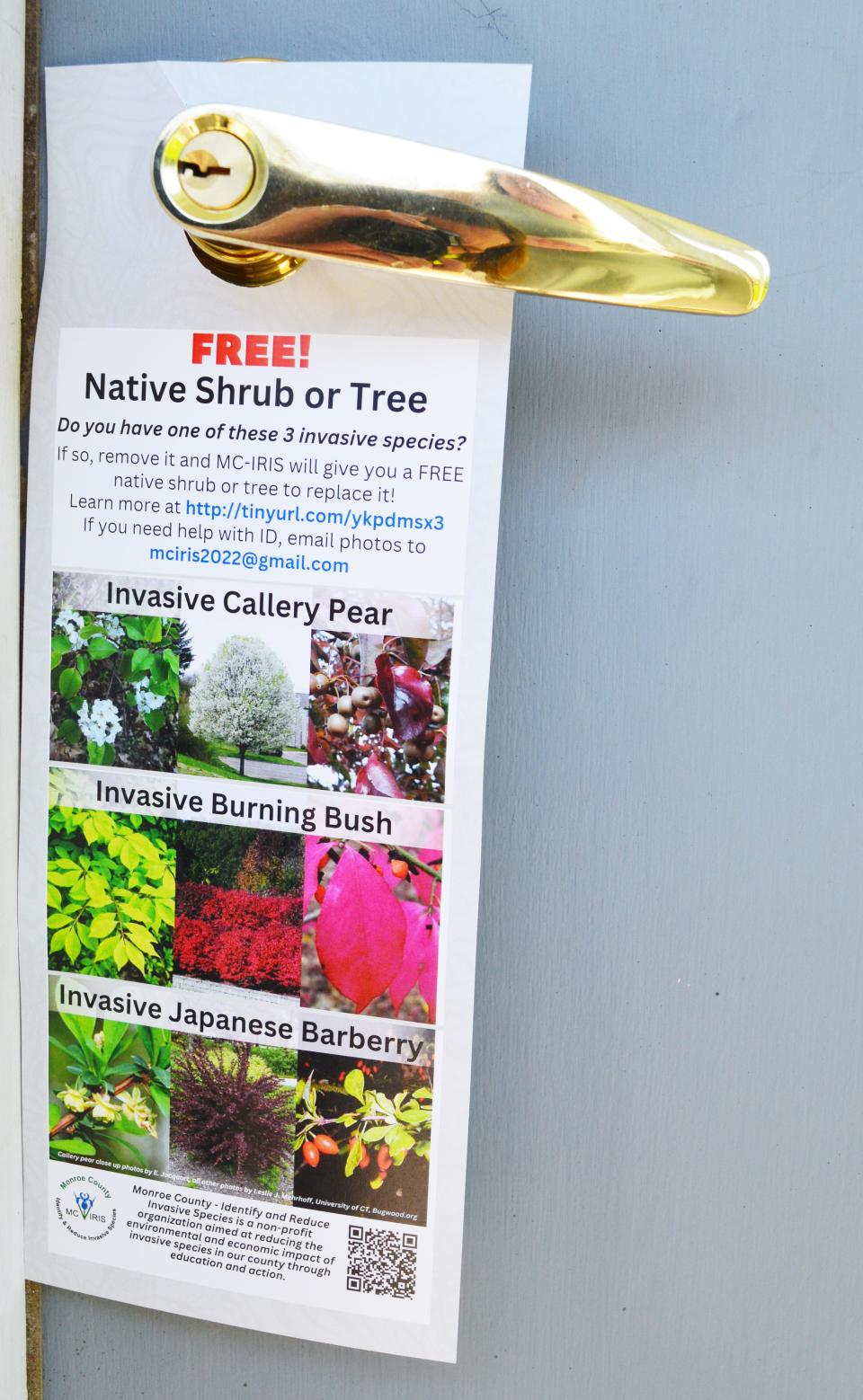These 3 popular landscaping plants could destroy Monroe County's forests
Once you know what to look for, you'll probably see invasive species that threaten area forests everywhere you look.
But it takes time for people to begin to recognize the spread of popular landscape plants, said Ellen Jacquart, president of MC-IRIS (Monroe County Identify and Reduce Invasive Species)
"It takes awhile to get it in the consciousness of the community," Jacquart said.
For the past five years, MC-IRIS has hosted the annual Reduce Invasive Species program, and this year it's educating Monroe County residents about three plants that can "escape" from front yards and manicured landscapes into the surrounding woods and fields.
Callery pear remains a problem in Bloomington
As more invasive plants in the Bloomington area "escape", it's become evident to MC-IRIS members that new invasive species needed to be added to the targeted list. But with so many Callery pear trees still growing in yards and along streets, the group decided to keep it on the list for a third year, Jacquart said.
"We realized (Callery pear) was such a huge problem for so many people that we needed to keep it on the list," Jacquart said. "Obviously, it’s still out there."

She said at least 75 people already have taken Callery pear — also known by its cultivar names including Bradford pear, Cleveland Select, Chanticleer and many others — out of their yards. Even so, there were many sites around Monroe County where just last month the white flowers blossomed along highways, in tree lines and near homes. In addition to replacing native trees, Callery pears take away native food for wildlife.
Burning bush, Japanese barberry added to list of targeted plants
The other two invasive plants on the list, burning bush and Japanese barberry, were ones that Jacquart planted in her yard about 25 years ago. Both are known for colorful leaves in the fall. Of course, Jacquart has ripped those plants out of her landscape, replacing them with native species.
Both the burning bush and Japanese barberry produce red berries that are eaten by birds, spreading them across the landscape. The gravity of the problem was shockingly depicted in a photograph capturing burning bush's red leaves carpeting the understory of an Indianapolis-area woods.

"This is acres," she said of the woods, "and it was just red, burning bush red."
The photographer, Jimmy Strathmann, has since removed about 75% of the burning bush. Jacquart said the spread of burning bush is new to Monroe County, meaning now is the best time to eradicate it. And it's been spotted by people in area woods.
"If you knew where to look you could see it popping up, in Morgan-Monroe State Forest and fence lines on farms."
Japanese barberry has several varieties with different leaf colors: One is a crimson/burgundy color in the fall; another has lime-green leaves. The "standard variety" has "plain old green leaves" that turn yellow in the fall, Jacquart said. All of them have thorns on the branches that can become thorny thickets in wooded areas after they escape.
"It can really mess up the understory of a woods," Jacquart explained.
Invasive animal: Watch out for jumping worms! They are bad for the soil, your garden and the environment
MC-IRIS program offers replacement plants
Take out an invasive tree or bush on your land in Monroe County and you can receive a native tree or shrub to replace it. Take out two trees and four bushes and you can get up to six native plants from MC-IRIS.
All the replacement trees and bushes are sourced from Woody Warehouse Nursery in Lizton, which is known for its high-quality stock, Jacquart said.
For replacement trees, people who provide a photo to show the invasive pear tree or trees they removed can choose from Alleghany serviceberry, American hornbeam, redbud, Pagoda dogwood, black gum or Shumard oak. All but the oak are relatively small trees, something that most people in past years have wanted, Jacquart said.
For the replacement bushes, Jacquart said there's a wide variety available. Some have red fall color similar to burning bush, such as hazelnut. Others have other colored leaves, including witch hazel. Some have colorful fruit or berries, such as black chokeberry and button bush. Also available are pawpaw, New Jersey tea, witch hazel, smooth hydrangea, pussy willow, elderberry, coralberry and blackhaw viburnam.
For more about the challenge and the replacement plants, go online to https://tinyurl.com/4zvvufnm.

New ways to promote the challenge program
In an effort to reach more Monroe County landowners, members of MC-IRIS will be visiting neighborhoods and residences to share information about invasive plants they may have on their property. While the hope is to talk to people, door hangers will be left if no one is home.
The door hangers give information about the three invasive plants that are targeted in 2024 and information on how to get a free tree or shrub.
For anyone who is uncertain if they have one of the invasive plants on their property, photographs can be emailed to mciris2022@gmail.com for help identifying them. Also anyone who has trouble filling out the online Google form can email the form, along with a photo, to the group's email.
Turn in the information by Aug. 1 to receive plants in the fall
All applications are due Aug. 1, whether they are submitted online or emailed.
Once all the orders have been placed, the shrubs and trees will be handed out 9 a.m.-1 p.m. Sept. 7 at Switchyard Park Maintenance Building, 1601 S. Rogers St., during the MC-IRIS Native Plant Sale.
Reach Carol Kugler at ckugler@heraldt.com.
This article originally appeared on The Herald-Times: How to replace burning bush, Japanese barberry, Callery pear for free

